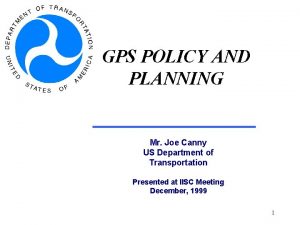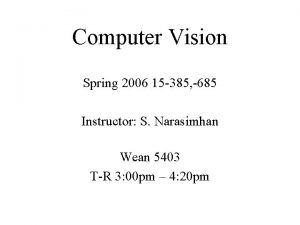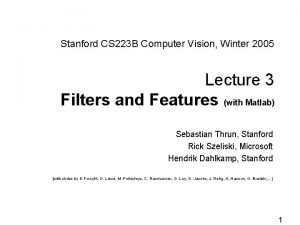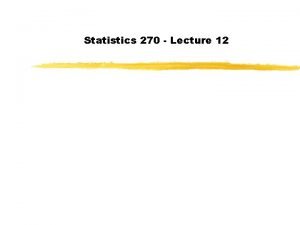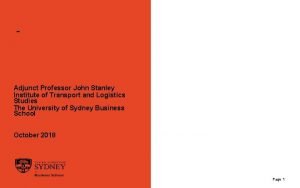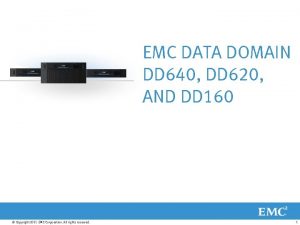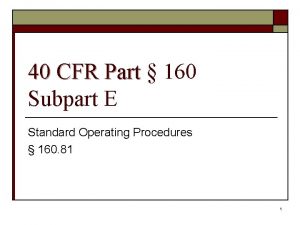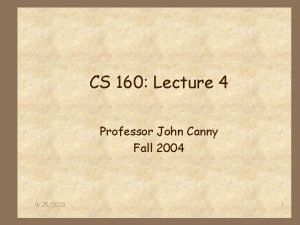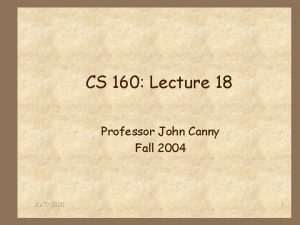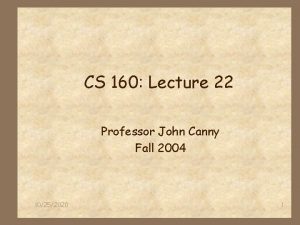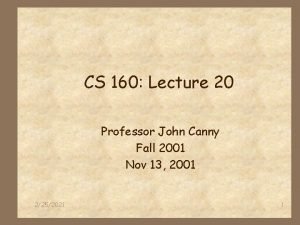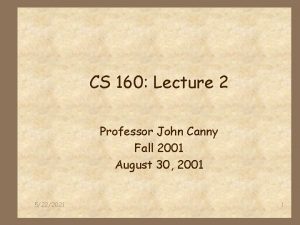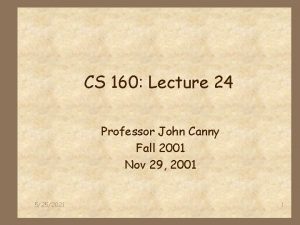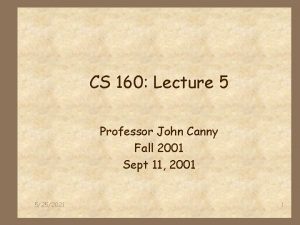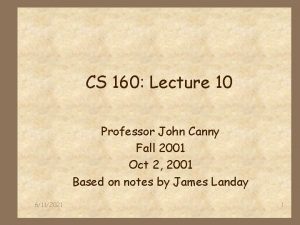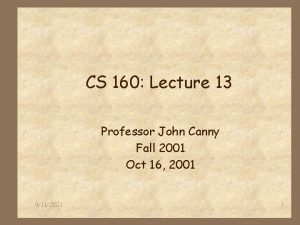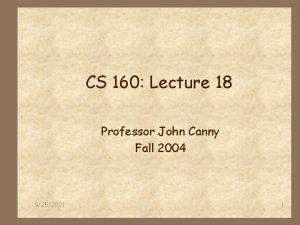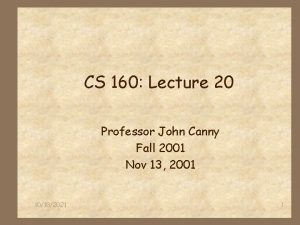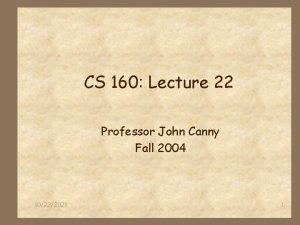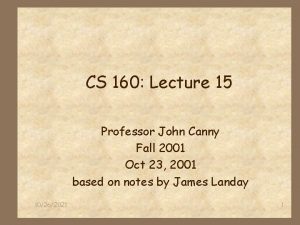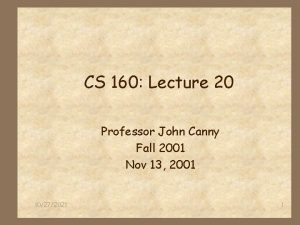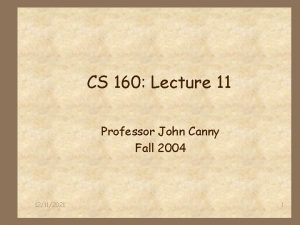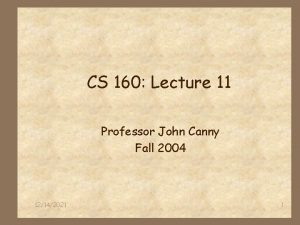CS 160 Lecture 16 Professor John Canny Fall





























- Slides: 29

CS 160: Lecture 16 Professor John Canny Fall 2001 Oct 25, 2001 based on notes by James Landay 10/17/2021 1

Outline 4 Review 4 Why do user testing? 4 Choosing participants 4 Designing the test 4 Administrivia 4 Collecting data 4 Analyzing the data 10/17/2021 2

Review 4 Personalization: How? 4 E-commerce: shopping carts, checkout 4 Web site usability survey * Readability of start page? * Graphic design? * Short vs. long anchor text in links? 10/17/2021 3

Why do User Testing? 4 Can’t tell how good or bad UI is until? * people use it! 4 Other methods are based on evaluators who? * may know too much * may not know enough (about tasks, etc. ) 4 Summary Hard to predict what real users will do Jakob Nielsen 10/17/2021 4

Choosing Participants 4 Representative of eventual users in terms of * job-specific vocabulary / knowledge * tasks 4 If you can’t get real users, get approximation * system intended for doctors + get medical students * system intended for electrical engineers + get engineering students 4 Use incentives to get participants 10/17/2021 5

Ethical Considerations 4 Sometimes tests can be distressing * users have left in tears (embarrassed by mistakes) 4 You have a responsibility to alleviate * * * make voluntary with informed consent avoid pressure to participate will not affect their job status either way let them know they can stop at any time [Gomoll] stress that you are testing the system, not them make collected data as anonymous as possible 4 Often must get human subjects approval 10/17/2021 6

User Test Proposal 4 A report that contains * * * * objective description of system being testing task environment & materials participants methodology tasks test measures 4 Get approved & then reuse for final report 10/17/2021 7

Selecting Tasks 4 Should reflect what real tasks will be like 4 Tasks from analysis & design can be used * may need to shorten if + they take too long + require background that test user won’t have 4 Avoid bending tasks in direction of what your design best supports 4 Don’t choose tasks that are too fragmented 10/17/2021 8

Data Types 4 Independent Variables: the ones you control * * Aspects of the interface design Characteristics of the testers Discrete: A, B or C Continuous: Time between clicks for double-click 4 Dependent variables: the ones you measure * Time to complete tasks * Number of errors 10/17/2021 9

Deciding on Data to Collect 4 Two types of data * process data + observations of what users are doing & thinking * bottom-line data + summary of what happened (time, errors, success…) + i. e. , the dependent variables 10/17/2021 10

Process Data vs. Bottom Line Data 4 Focus on process data first * gives good overview of where problems are 4 Bottom-line doesn’t tell you where to fix * just says: “too slow”, “too many errors”, etc. 4 Hard to get reliable bottom-line results * need many users for statistical significance 10/17/2021 11

The “Thinking Aloud” Method 4 Need to know what users are thinking, not just what they are doing 4 Ask users to talk while performing tasks * * tell us what they are thinking tell us what they are trying to do tell us questions that arise as they work tell us things they read 4 Make a recording or take good notes * make sure you can tell what they were doing 10/17/2021 12

Thinking Aloud (cont. ) 4 Prompt the user to keep talking * “tell me what you are thinking” 4 Only help on things you have pre- decided * keep track of anything you do give help on 4 Recording * use a digital watch/clock * take notes, plus if possible + record audio and video (or event logs) 10/17/2021 13

Administrivia 4 Yep, we know the server is down 4 Could be a hard or easy fix 4 Check www. cs. berkeley. edu/~jfc for temp replacement 4 Please hand in projects tomorrow. 4 Use zip and email if no server. 10/17/2021 14

Using the Test Results 4 Summarize the data * make a list of all critical incidents (CI) + positive & negative * include references back to original data * try to judge why each difficulty occurred 4 What does data tell you? * UI work the way you thought it would? + consistent with your cognitive walkthrough? + users take approaches you expected? * something missing? 10/17/2021 15

Using the Results (cont. ) 4 Update task analysis and rethink design * rate severity & ease of fixing CIs * fix both severe problems & make the easy fixes 4 Will thinking aloud give the right answers? * not always * if you ask a question, people will always give an answer, even it is has nothing to do with the facts * try to avoid specific questions 10/17/2021 16

Measuring Bottom-Line Usability 4 Situations in which numbers are useful * time requirements for task completion * successful task completion * compare two designs on speed or # of errors 4 Do not combine with thinking-aloud. Why? * talking can affect speed & accuracy (neg. & pos. ) 4 Time is easy to record 4 Error or successful completion is harder * define in advance what these mean 10/17/2021 17

Some statistics 4 Variables X & Y 4 A relation (hypothesis) e. g. X > Y 4 We would often like to know if a relation is true * e. g. X = time taken by novice users * Y = time taken by users with some training 4 To find out if the relation is true we do experiments to get lots of x’s and y’s (observations) 4 Suppose avg(x) > avg(y), or that most of the x’s are larger than all of the y’s. What does that prove? 10/17/2021 18

Significance 4 The significance or p-value of an outcome is the probability that it happens by chance if the relation does not hold. 4 E. g. p = 0. 05 means that there is a 1/20 chance that the observation happens if the hypothesis is false. 4 So the smaller the p-value, the greater the significance. 10/17/2021 19

Significance 4 And p = 0. 001 means there is a 1/1000 chance that the observation happens if the hypothesis is false. So the hypothesis is almost surely true. 4 Significance increases with number of trials. 4 CAVEAT: You have to make assumptions about the probability distributions to get good p-values. 10/17/2021 20

Normal distributions 4 Many variables have a Normal distribution 4 At left is the density, right is the cumulative prob. 4 Normal distributions are completely characterized by their mean and variance (mean squared deviation from the mean). 10/17/2021 21

Normal distributions 4 The difference between two independent normal variables is also a normal variable, whose variance is the sum of the variances of the distributions. 4 Asserting that X > Y is the same as (X-Y) > 0, whose probability we can read off from the curve. 10/17/2021 22

Analyzing the Numbers 4 Example: trying to get task time <=30 min. * * * test gives: 20, 15, 40, 90, 10, 5 mean (average) = 30 median (middle) = 17. 5 looks good! wrong answer, not certain of anything 4 Factors contributing to our uncertainty * small number of test users (n = 6) * results are very variable (standard deviation = 32) + std. dev. measures dispersal from the mean 10/17/2021 23

Analyzing the Numbers (cont. ) 4 Crank through the procedures and you find * 95% certain that typical value is between 5 & 55 4 Usability test data is quite variable * need lots to get good estimates of typical values * 4 times as many tests will only narrow range by 2 x + breadth of range depends on sqrt of # of test users * this is when online methods become useful + easy to test w/ large numbers of users (e. g. , Net. Raker) 10/17/2021 24

Measuring User Preference 4 How much users like or dislike the system * can ask them to rate on a scale of 1 to 10 * or have them choose among statements + “best UI I’ve ever…”, “better than average”… * hard to be sure what data will mean + novelty of UI, feelings, not realistic setting, etc. 4 If many give you low ratings -> trouble 4 Can get some useful data by asking * what they liked, disliked, where they had trouble, best part, worst part, etc. (redundant questions) 10/17/2021 25

Comparing Two Alternatives 4 Between groups experiment * two groups of test users * each group uses only 1 of the systems 4 Within groups experiment * one group of test users A B + each person uses both systems + can’t use the same tasks or order (learning) * best for low-level interaction techniques 4 Between groups will require many more participants than a within groups experiment 4 See if differences are statistically significant * assumes normal distribution & same std. dev. 10/17/2021 26

Experimental Details 4 Order of tasks * choose one simple order (simple -> complex) + unless doing within groups experiment 4 Training * depends on how real system will be used 4 What if someone doesn’t finish * assign very large time & large # of errors 4 Pilot study * helps you fix problems with the study * do 2, first with colleagues, then with real users 10/17/2021 27

Reporting the Results 4 Report what you did & what happened 4 Images & graphs help people get it! 10/17/2021 28

Summary 4 User testing is important, but takes time/effort 4 Early testing can be done on mock-ups (low-fi) 4 Use real tasks & representative participants 4 Be ethical & treat your participants well 4 Want to know what people are doing & why * i. e. , collect process data 4 Using bottom line data requires more users to get statistically reliable results 10/17/2021 29
 Imagem de uma rampa fonte max pixel
Imagem de uma rampa fonte max pixel What is canny edge detection in image processing
What is canny edge detection in image processing Filtre sobel python
Filtre sobel python Targil seasoning
Targil seasoning Joe canny
Joe canny Canny
Canny Canny
Canny Canny sebastian
Canny sebastian Edge detection
Edge detection Promotion from associate professor to professor
Promotion from associate professor to professor A college professor never finishes his lecture
A college professor never finishes his lecture What is this
What is this 01:640:244 lecture notes - lecture 15: plat, idah, farad
01:640:244 lecture notes - lecture 15: plat, idah, farad Professor john forsythe
Professor john forsythe Professor john forsythe
Professor john forsythe Professor john wood
Professor john wood Professor john holland's self directed search
Professor john holland's self directed search Feedback hattie effect size
Feedback hattie effect size Professor john hughes
Professor john hughes Professor john stanley
Professor john stanley 600 sayısının yüzde yirmi eksiği kaçtır
600 sayısının yüzde yirmi eksiği kaçtır Smt 160
Smt 160 12vac35-105-160
12vac35-105-160 Wac 296-800-160
Wac 296-800-160 Anticorps anti-nucléaire positif moucheté
Anticorps anti-nucléaire positif moucheté Konica minolta bizhub 160
Konica minolta bizhub 160 Parafrasi il canto delle sirene
Parafrasi il canto delle sirene Dd160 emc
Dd160 emc 40 cfr part 160
40 cfr part 160 Carolina windom
Carolina windom




